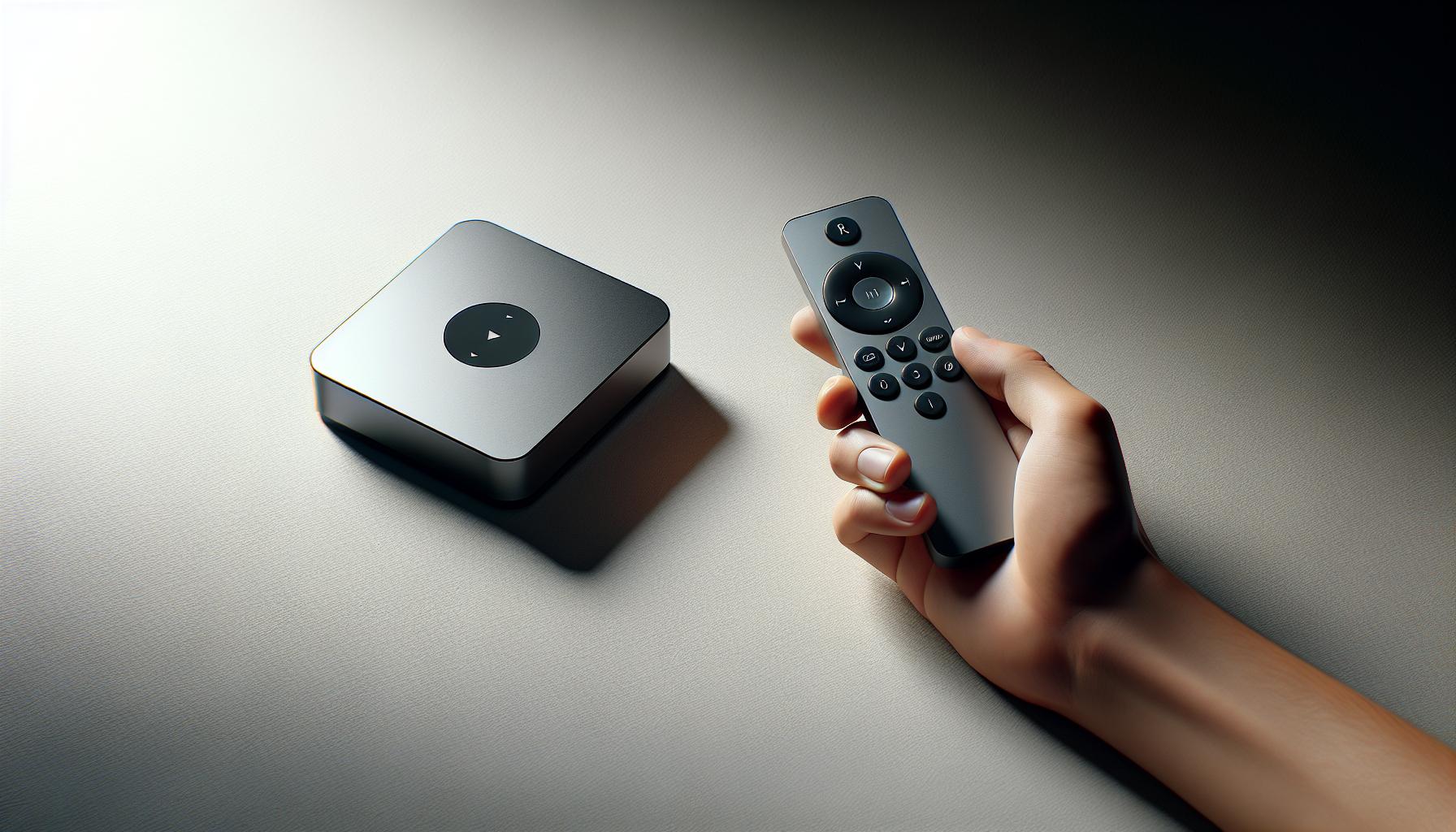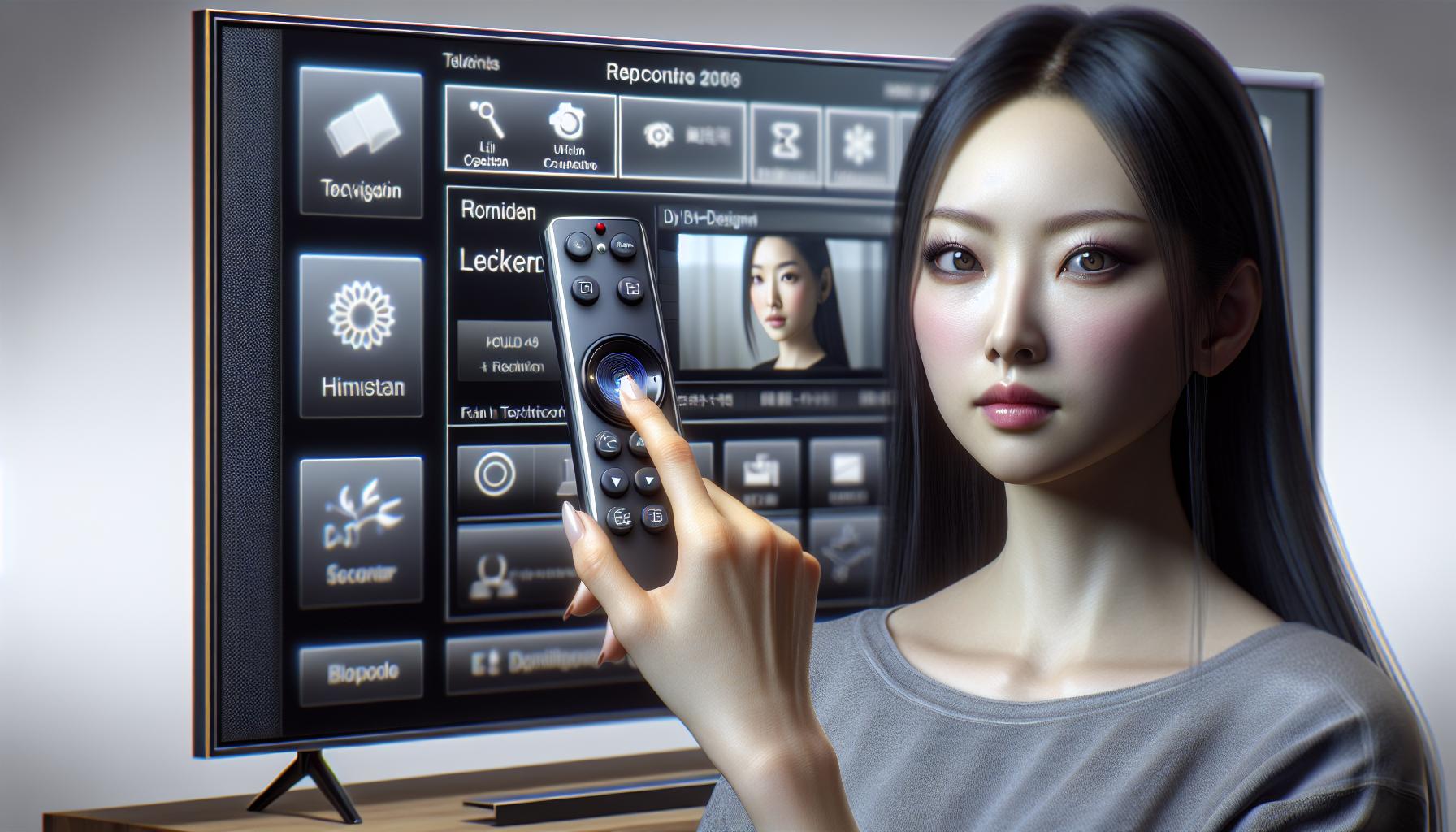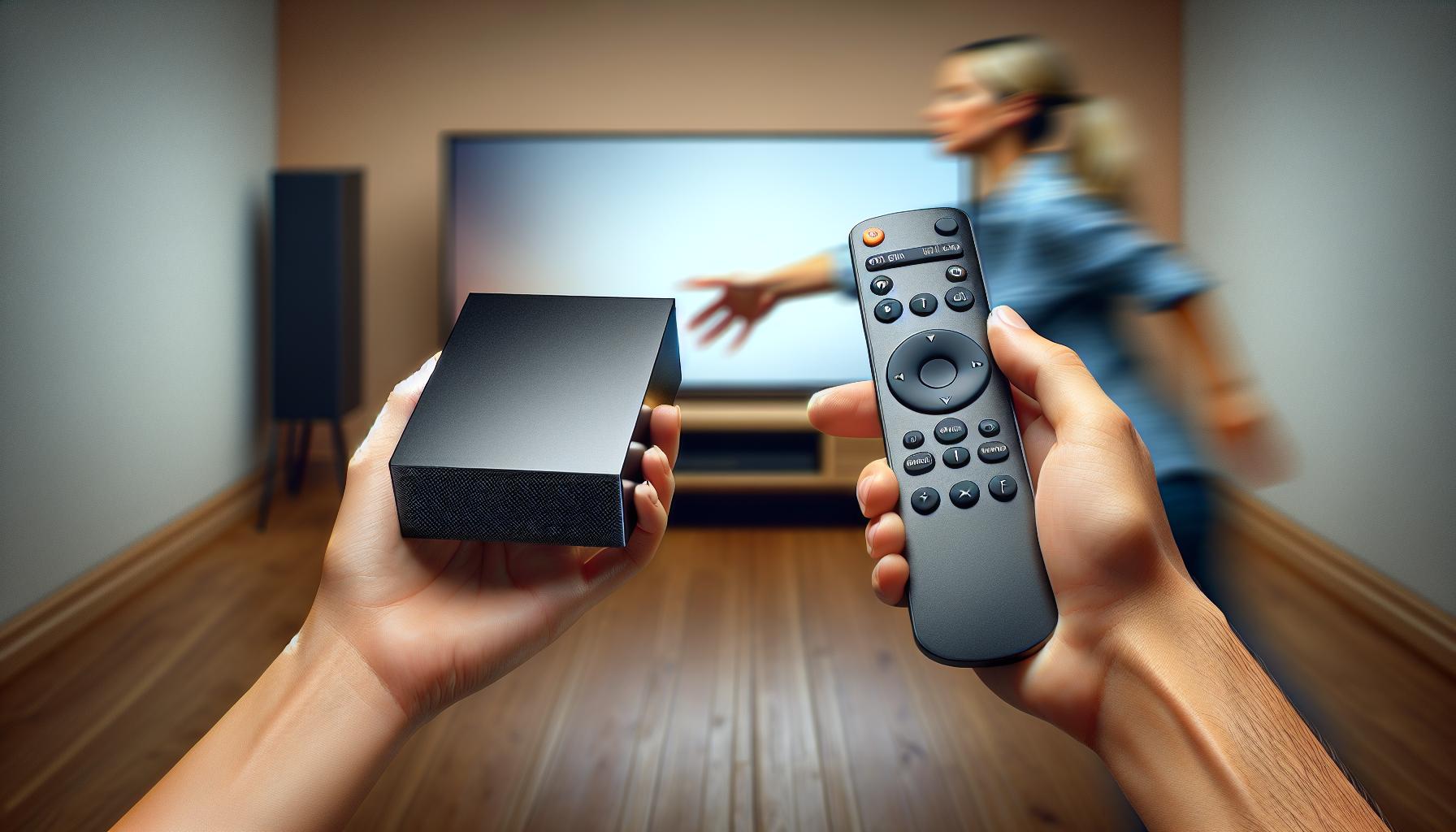Ever found yourself struggling with your Apple TV remote? You're not alone. It's a common issue that can be easily resolved once you know how to pair it properly.
In this guide, we'll walk you through the steps on how to pair your Apple TV remote. It's simpler than you might think and you'll have it done in no time.
What is the Apple TV remote?
Introduced by Apple Inc., the Apple TV Remote is a sleek, minimalist wireless input device designed for controlling your Apple TV. Shaped like a slim rectangle, it's small enough to fit comfortably in the palm of your hand, making it easy to navigate through your favorite entertainment options.
Distinctively different from traditional remotes, you won't find an extensive range of buttons on the Apple TV Remote. Instead, there's a touch-sensitive trackpad (aka the Touch surface) at the top, allowing for fast, intuitive navigation. Swipe on it, and you're flipping through options, menus, and screens in no time. Turn it sideways, and it behaves like a game controller.
While fewer buttons may seem daunting, you'll appreciate its simplicity. A Menu button, a TV/Home button and volume controls - that's all you need for most functions. For your convenience, there's also a Siri button which activates Apple's voice assistant on-demand, making it even easier to find what you want to watch or listen to.
You might be wondering about the *battery life of the Apple TV Remote. No worries, it's built to last. The internal, lithium-ion battery runs for months between charges under normal usage. When it's time for a recharge, simply plug it in with a Lightning-to-USB cable, just like you would with your iPhone or iPad.
True to Apple's design philosophy, the Apple TV Remote embraces simplicity and enhances usability. It's more than a remote — it's a powerful tool, engineered for your entertainment comfort. In the following sections, we'll guide you on how to pair it properly and make the best use of it, ensuring a smooth, hassle-free viewing experience.
Why do you need to pair your Apple TV remote?

Understanding "why" you need to pair the Apple TV remote adds to the usability and overall user experience. Firstly, let's tackle what pairing means in this context. When two Bluetooth devices such as your Apple TV and its remote connect exclusively, it's called pairing. This close connection ensures that your remote commands are solely received by your Apple TV and not by other devices.
Pairing is not just for initial setup but also plays a critical role in streamlining your digital life. If your Apple TV remote isn't paired, then it simply won't function optimally. It could be slow to respond or may not respond at all to your commands. It can also interfere with other Bluetooth devices around if not paired explicitly with the Apple TV.
Pairing the remote is a breeze, and once achieved, you'll have direct control over your Apple TV without interference from other gadgets. It enhances the reliability and accuracy of your commands, ensuring your favorite streaming service or app launches swiftly and without glitches.
Step 1: Prepare your Apple TV and remote

Perfect, now that you're equipped with the understanding of your Apple TV remote's functionality, let's move on to ensuring you've the optimal setup for pairing your device. This stage is crucial, folks! Failure to accurately setup could lead to connection issues which can be a roadblock in your seamless viewing experience.
First on the agenda, verify your remote's battery level. In order for the remote to properly pair, it's essential that it has a sufficient battery level, ideally fully charged. Exhaling a sigh of relief because your remote's fully juiced up? Great, we're ready to take the next step.
Secondly, make sure your Apple TV is powered on and properly connected to your television. Ensure that it's displaying correctly on your TV. If the Apple TV isn't correctly displaying, you may need to check the HDMI cable connections.
Another essential aspect to consider is the proximity between your Apple TV and the remote. When pairing, these two should be within range (approximately 5 inches apart) to ensure the pairing process runs smoothly.
Also, just as important, check you're not having any other Bluetooth devices active in the vicinity as they can cause interference. It's always a wise strategy to have all other devices switched off or moved away.
In case you've any additional remotes paired with your Apple TV (e.g., game controllers), we recommend you to unpair them before starting the process with your new remote. This measure is recommended to avoid possible confusion to the receiver and to guarantee a clean and direct pairing.
Step 2: Put the remote into pairing mode
Let's dive right into the crux of the matter - getting your remote into pairing mode. The process is simple, yet precise and we're here to guide you each step of the way.
To kick things off, make sure your remote has power. You can do this by pressing any button on the remote. If it's not responding, try charging it for a while and re-attempt the process.
The next step is quite simple - you've to hold the remote close to your Apple TV. Remember, proximity is key because the Apple TV remote relies on a Bluetooth connection to pair with the Apple TV. Ideally, five inches or less should do the job. There's a prime balance you've got to achieve - close, but not too close.
Now comes the pairing bit. If you're using a Siri Remote or an Apple TV Remote, let's have you press and hold the Menu and Volume Up buttons simultaneously. Do this until your remote starts to send a pairing signal - your Apple TV will recognize it.
Got an Aluminum or White remote? For these, depress and hold the Menu and Right buttons together for approximately six seconds. Yes, keep an eye on the clock!
Seeing a chainlink icon on your screen signifies a successful pairing request. Here's a key reminder though - do not rush the process. Patience is your strongest ally during this techie mission.
Voila! You've put your remote into pairing mode, which brings us a step closer to your goal. The journey is not over just yet. In our next section, we'll steer you through the process of confirming the connection between the devices. Mull over these steps again if you need to - remember, repetition is the mother of mastery.
Step 3: Pair the remote with your Apple TV
So, you've managed to get your Apple TV remote into pairing mode. Wonderful job! Now, let's get it synced with your Apple TV. Close proximity is the key here. Stand close to your TV, ideally less than one foot away to ensure the devices can communicate effectively.
For the Siri Remote or Apple TV Remote, hold down the Menu button and the Volume Up button simultaneously. Keep them pressed for about five seconds. On your Apple TV screen, you should see a notification stating that a remote is attempting to pair. Heavy emphasis: Release the buttons only when you see this message!
Moving onto users with the Apple Remote (aluminum or white), your actions will be a bit different. Simply press and hold the Menu button and the Left button together for six seconds or so. You're waiting for a chainlink symbol appearing on your screen that indicates the pairing process has started.
Let's not forget about the Apple TV Remote app users. Open the app on your iOS device and tap on Add Apple TV. Go on, don't be shy! Choose your Apple TV from the list of available devices. A four-digit code will pop up on your TV screen. Punch in that code into your iOS device and voilà!
Working with an unusable or lost remote? Don't worry, you're covered! Use your iOS device and access the control center. Press and hold the Apple TV button. Tap on the Apple TV icon and punch in the four-digit code that appears for you on the screen.
Following these steps carefully guarantees successful pairing of your remote. It could take a few moments though, so show some patience. Remember, all good things take time. It's a simple as that! But let's not rest just yet, there's more ahead. The next topic will enlighten you on confirming the successful connection between these devices. So, stick around, you're doing great.
Step 4: Test the remote

Having completed the pairing process, you wouldn't want to leave without making sure the remote is fully functional. It’s time to find out whether all your efforts have paid off by testing your Apple TV remote.
To begin testing, you must wake up your Apple TV. Press any button on the remote to power up the TV. It's crucial to point out that if your paired remote is the only control device linked to the Apple TV, pressing any button on the remote should wake it up.
Now comes the moment of truth: exploring functionality. Try navigating menus, change channels or adjust the volume. Observe whether your Apple TV responds accurately to all your commands. If it reacts as expected, you've got a successfully paired remote.
But what if things aren't quite going as planned? If your Apple TV isn't fully responding to the remote, there might be a blockage. Make sure there's no obstruction between the Apple TV and the remote. Other electronic devices, furniture, and even thick dust buildup can create interference. Ensure that the path is clear and repeat the testing.
In exceptional cases, it's possible to face a completely unresponsive Apple TV during the testing process. If this happens, don’t panic - there's a solution. Simply restart the device. Most problems get resolved when you reboot the Apple TV. To do this, you'll need to disconnect the Apple TV from power, then reconnect it after a few seconds. This process usually shakes off any minor bugs and should help get your remote and Apple TV back on track.
Not all technical challenges can be overcome with simple tactics though. If your Apple TV is still not responding even after rebooting, it’s time to evaluate. A faulty device - whether the remote or the TV itself - may be the cause. To discern the issue you might need professional assistance from the Apple support. Staying patient and persistent is key.
Conclusion
You've now mastered the art of pairing your Apple TV remote. Remember, proximity is key during the process. After successfully pairing, don't forget to test your remote to ensure it's working perfectly. If you encounter any hiccups, clear any obstructions and try a device restart. Should issues persist, don't hesitate to reach out to Apple support. You're now ready to enjoy a seamless viewing experience with your Apple TV. Happy streaming!
Frequently Asked Questions
How can I pair my Apple TV remote with my Apple TV?
To pair your Apple TV remote, go through the provided step-by-step instructions in our article. The most critical step is to ensure you are in close proximity to your Apple TV during this process.
What do I do after pairing the Apple TV remote?
After pairing your remote, it's essential to test its functionality. You can go through this by trying out the remote's different commands and features.
What if my Apple TV is unresponsive after pairing?
If your Apple TV remains unresponsive after pairing, check to see if there are any obstructions. Try restarting your device. If the problem persists, do not hesitate to seek Apple's professional assistance.
Should I always be close to my Apple TV while pairing the remote?
Yes, the pairing process is most successful when you are in close proximity to your Apple TV. This is because remote commands are transmitted best at shorter distances.
When should I contact Apple support?
If you've performed the steps correctly, removed potential obstructions, and the issue still persists, it's time to reach out to Apple support. They are equipped to handle complex issues and provide further assistance.




